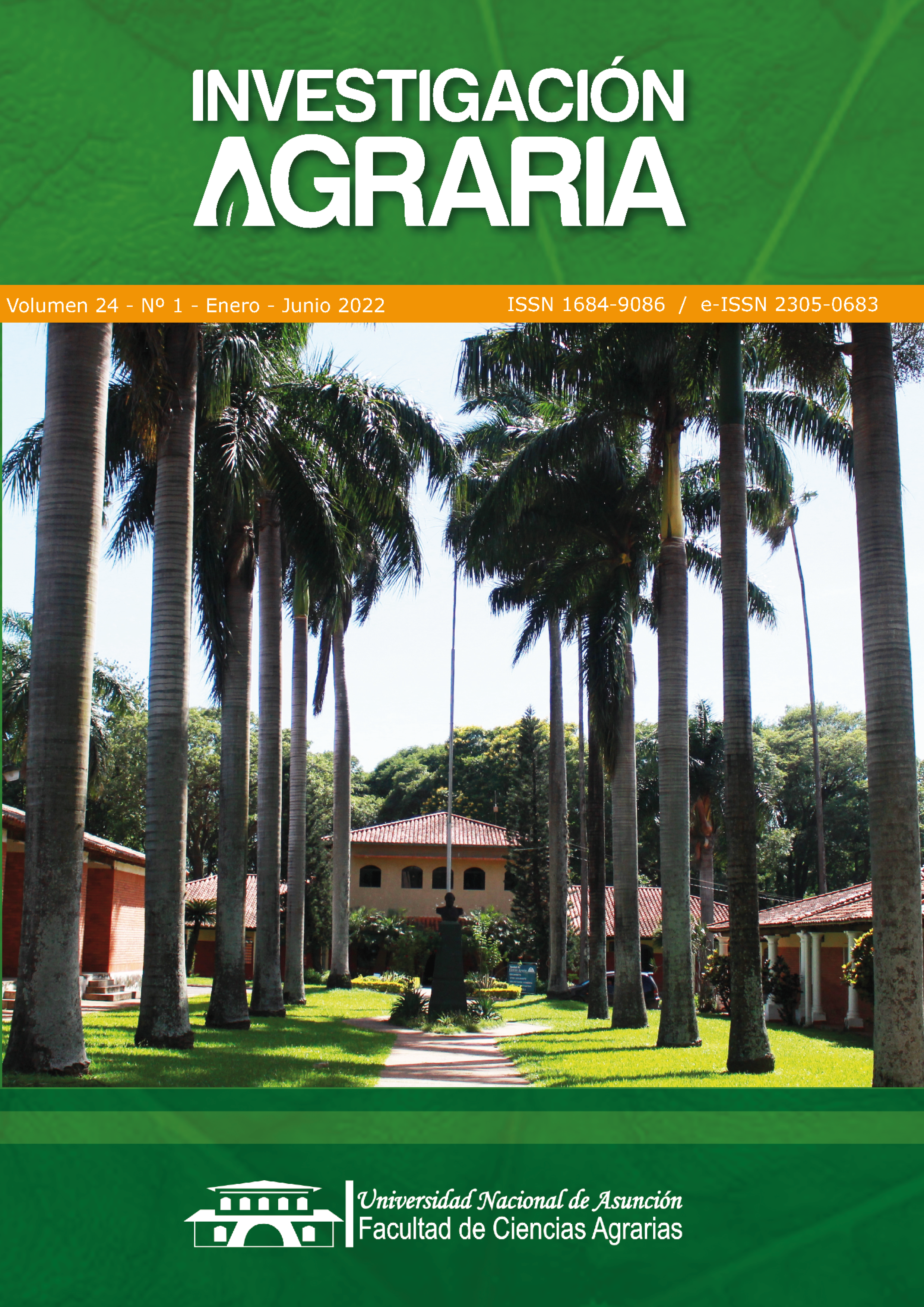Use of rice bran in the diet of ewes in feedlot
DOI:
https://doi.org/10.18004/investig.agrar.2022.junio.2401679Keywords:
consumption, feed conversion, weight gain, sheep, rice by-productsAbstract
The rice bran is a by-product of the rice industries that has important nutritional values and can therefore be considered as an alternative to include them in a sheep’s food program. The objective of the work was to evaluate the effect of partial replacement of ground corn by rice bran on productive parameters of sheep in feedlot. The experimental design was completely randomized with four treatments and three repetitions, each repetition was composed of 2 ewes, thus totaling 12 experimental units (24 animals of 26 ± 2kg PV on average). The treatments consisted of the partial substitution of ground corn for rice bran in the diet. The levels were 0% for T1, 15% for T2, 30% for T3 and 45% for T4. The rations also contained soybean expeller, mineral salt, urea, calcium carbonate and Pangola hay (Digitaria decumbens) as a voluminous source. The duration of the experiment was 56 days. The weightings and ration adjustment were made every 14 days. The data collected were subjected to an Analysis of variance (ANOVA) at 5% error probability. The results obtained indicate that there were no significant statistical differences in the variables daily weight gain, total weight gain, intake and feed conversion ratio, with average values of 200 g.dia-1, 10.8 kg, 4.7% and 7.4 respectively. Therefore, it can be inferred that it is feasible to use rice bran instead of ground corn up to 45% without affecting the productive parameters evaluated.Downloads
Metrics
References
Bhosale, S. & Vijayalakshmi, D. (2015). Processing and nutritional composition of rice bran. Current Research Nutrition and Food Science Journal., 3(1), pp. 74-80.
Cutrim, D. O., Alves, K. S., Oliveira L. R., Dos Santos, R. C., Da Mata, V. J., Do Carmo, ... Carvalho, F. F. (2012). Elephant grass, sugarcane, and rice bran in diets for confined sheep. Trop Anim Health Prod., 44(8), 1855–1863
Flakemore, A. R., Otto, J. R., Suybeng, B., Balogun, R. O., Malau-Aduli, B. S., Nichols, P. D. & MalauAduli, A. E. (2015). Performance and carcass characteristics of Australian purebred and crossbred lambs supplemented with Rice Bran. Journal of Animal Science and Technology, 57, 36.
Forster Jr., L. A., Goetsch, A. L., Galloway Sr., D. L., Sun, W., Patil, A. R. & Johnson, Z. B. (1994). Digestion characteristics feed intake and live weight gain by cattle consuming forage supplemented with defatted rice bran or other feedstuffs. Animal Feed Science and Technology, 47, pp. 259 –275
Gadberry, M. S. & Gunter, S. A. (2007). Rice milling coproducts as feedstuffs for beef cattle. The professional Animal Scientist, 23 (4), pp. 309315.
Garg, A. K., Singh, P., Malik, R. & Agrawal, D. K. (2004). Effect of replacing maize grain with de-oiled rice bran on intake and utilization of nutrients in adult ewes. Small Ruminant Research, 52, pp. 75–79
Lallo, C. H. O. (1996). Feed intake and nitrogen utilization by growing goats fed by-product based diets of different protein and energy levels. Small Ruminant Research, 22, pp. 193– 204.
Mendoza, G. D., Plata, F. X., Ramirez, M., Mejia, M. A., Lee, H. y Barcena, R. (2007). Evaluación de alimentos integrales para el engorde intensivo de ovinos. Revista Científica (Maracaibo), 17 (1), pp. 72-82
Muhammad, N., Maigandi, S. A., Hassan W. A. & Daneji A. I. (2008). Growth performance and economics of sheep production with varying levels of rice milling waste. Sokoto Journal of Veterinary Sciences, 7(1), pp. 59-64.
Salinas-Chavira, J., Perez, J. A., Rosales, J. A., Hernandez, E. A. & La O., O. (2013). Effect of increasing levels of rice polishings on ruminal dry matter degradability and productive performance of fattening sheep. Cuban Journal Agriculture Science, 47(4), pp. 375–380.
Sampedro, D. (2015). El afrecho de arroz, un subproducto regional de importancia para la alimentación de los vacunos. Hoja informativa N° 79. Edición EEA INTA Mercedes. 5 p
Singh, A. S., Jain, V. K., Singh, P. & Pathak, N. N. (2000). Effect of feeding wheat bran and deoiled rice bran on feed intake and nutrient utilization in crossbred cows. Indian Journal of Animal Science, 70, 1258–1260.
Tabeidian, S. A. & Sadeghi, G. H. (2009). Effect of replacing barley with rice bran in finishing diet on productive performance and carcass characteristics of Afshari lambs. Tropical Animal Health Production, 41, pp. 791-796.
USDA (United States Department of Agriculture). (2019). Rice Outlook. Economic Research Service. Situation and Outlook Report, 22p.
Published
How to Cite
Issue
Section
License
Copyright (c) 2022 Jorge Daniel Caballero Mascheroni, Javier Feliciano Gonzalez Cabañas, Luis Alberto Alonzo Griffith, Diego Avilio Ocampos Olmedo, Tania Fariña Diaz, Mauricio Alejandro Aguilar Sosa

This work is licensed under a Creative Commons Attribution 4.0 International License.
All content in this journal is under Creative Commons Attribution License.









 All content in this journal is under
All content in this journal is under 